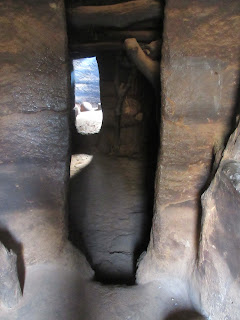 |
| Baobab Express: "Move and win together - it's good." |
As mentioned in our post on northern Benin (as with most west African countries, the share of Muslims in the population rises as you head north towards the Sahel), some Beninois were unimpressed by the relative religiosity of the residents of Djougou.
 |
| Former cinema, Djougou. |
Our driver and front-seat passengers (a total of four people up front if you count the toddler, but nobody does when considering occupancy) remarked that the people of Djougou were too strict - they looked askance at drinking alcohol or incorporating traditional practices into Islam. To be fair, our taxi's occupants also criticized exclusive fidelity to Christianity too. There was indeed a marked difference between Djougou and other parts of Benin both to the north and south. More women wore hijabs and in some cases also covered their faces and feet and even hands, and buvettes (bars) were harder to find.
 |
| "The drum of modern times in the Donga." |
In addition to what our fellow travelers had to say, Djougou is also known for a vibrant handicraft trade. We inquired about jewelry and ended up walking a winding route to the blacksmiths' section of town, where Blair picked up a couple of large bracelets made from camions casses - broken trucks.
 |
| On the way to the metalworkers' district. |
Next we went to Espace Tissage, where apprentices learn to weave fabric out of cotton. The pieces are up to 16 meters long; the cotton slowly makes its way across the floor to the loom. Apprentices (all of whom were female the day we went) work at the center three days a week, and are at home the other days. Our taxi driver, Manaf, noted that many of the apprentices are from outlying areas where they may have limited opportunities (and would likely be working a lot around the household when at home).
Considering the relative conservatism and roaming many dusty roads to visit blacksmiths and weavers, Djougou definitely seemed more like The Gambia than anywhere else we've visited in central Africa.
 |
| Cheese in stew with igname pilee at right. The cheese was so delicious. Below: cheese for sale. |
 |
| "Who am I?" Transport |
 |
| A statue of Ahossou Soha, the first king of Savalou, greeted us as we passed through the town. |











































![Expat [DESTINATIONCOMPLETE]](http://www.expat.com/logo/expatBlogSmall.gif)